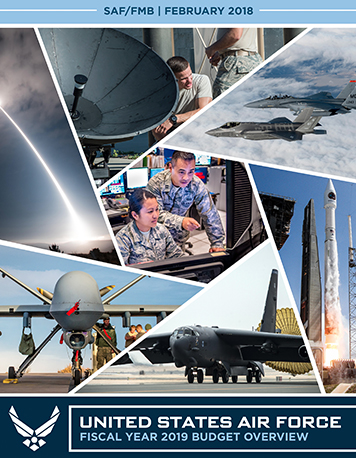
The Air Force budget request for FY 2019 is approximately $156.3 billion dollars, a 6.6% overall increase from the FY 2018 request. This budget moves us forward to outpace the efforts of our competitors and aligns with the National Security Strategy, the National Defense Strategy, and Air Force priorities. Key areas addressed by this budget include readiness, people, nuclear deterrence, modernization, space superiority, multi-domain command and control, air superiority, light attack and science and technology.
Our FY 2019 budget shows modest growth in O&M. We invest in upgrades to the ISR fleet in order to mitigate capability gaps in transmitting ISR data to decision makers---a key element to improving lethality. To free Air Force pilots to perform other missions, we expand our Adversary Air (ADAIR) contract at Nellis Air Force Base to provide additional live training engagements. The baseline budget increases funding for our two largest readiness accounts, by funding nearly 1.2 million peacetime flying hours and resourcing our Weapon System Sustainment (WSS) requirements at a manageable level of risk. Additionally, we enhance the network of Global Command and Control systems that enable surveillance, early warning of weather and airborne events, worldwide cyber connectivity with warfighter systems, and air traffic control.
Our FY 2019 PB request for MILPERS supports increased end strength to further reduce critical gaps in our force and provides funding to recruit, train and develop resilient and competent Airmen, focused on leading multi-domain operations as part of the Joint and Combined Force. In particular, this budget targets shortfalls in Intelligence, Surveillance and Reconnaissance (ISR), Remotely Piloted Aircraft and cyber career fields. Additionally, in areas where we have previously closed the manning gap, the focus shifts to closing the experience gap.
Innovation continues to be an Air Force imperative, as we are faced with an eroding technology advantage in an international environment of great power competition. The FY 2019 RDT&E budget invests heavily in innovative technologies, funds the modernization of our nuclear force, transforms major space capabilities to better perform in a contested environment and continues investment in the Air Superiority family of systems. Funding also focuses on game-changing technologies, such as hypersonics, directed energy, unmanned autonomous artificial intelligence and machine learning systems, and nanotechnology.
Our FY 2019 Procurement accounts continue stable growth from FY 2018 to FY 2019 as we continue procurement of the F-35A and KC-46A, begin procurement of the Combat Rescue Helicopter, increase preferred munitions, and begin the pivot to a defendable, survivable space posture. Within our munitions account we have included funding, through a combination of base and OCO, to maximize current industry capacity.
In the MILCON FY 2019 request, the Air Force continues to focus on new weapon system beddowns, strengthening the nuclear enterprise, and modernizing our research, development and test infrastructure. The budget supports Combatant Commanders’ highest construction priorities, improves the posture of the forces in Europe, and enhances Indo-Pacific Resiliency.
Our FY 2019 Overseas Contingency Operations budget prioritizes on-going operations in Iraq, Afghanistan and Syria, expands efforts to deter Russian aggression through the European Deterrence Initiative and continues global counterterrorism operations and builds military readiness.
This FY19 Budget Request is a critical step toward addressing the issues raised by our leaders. Air and space power are indispensable to every joint operation….and the FY19 budget request is aligned with the recently approved National Defense Strategy, prioritizing long-term competition with China and Russia. This budget sets the conditions to deliver a lethal, globally responsive, United States Air Force. Together, we can build the Air Force our nation needs….with the right size and mix of agile capabilities to compete, deter, and win in the complex international environment we face today and into the future.